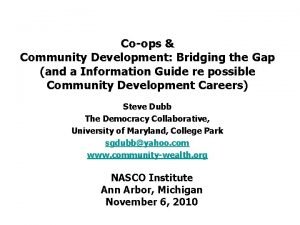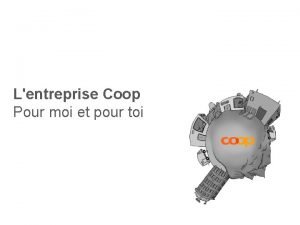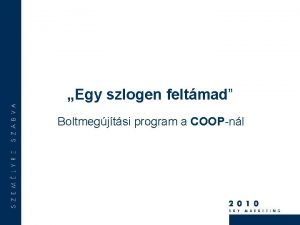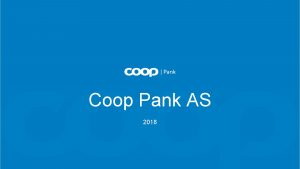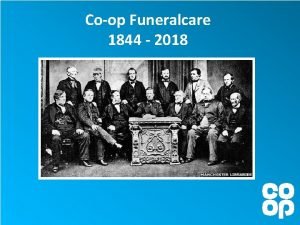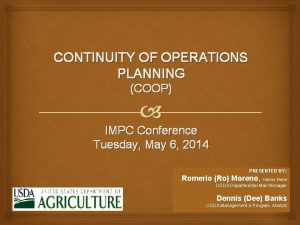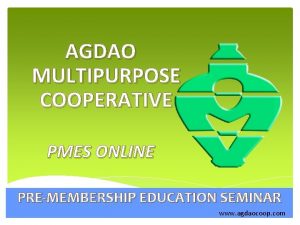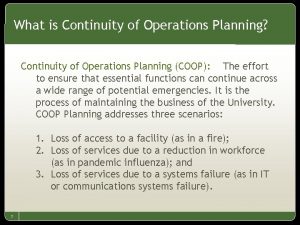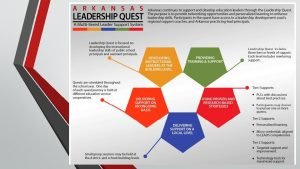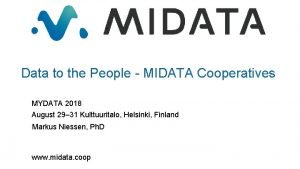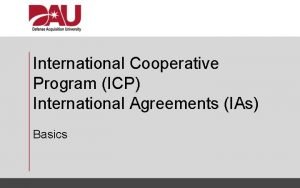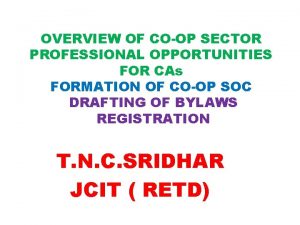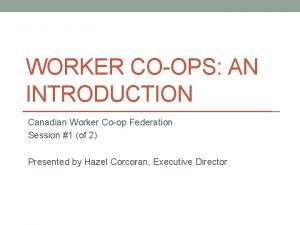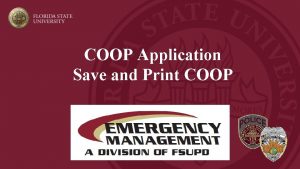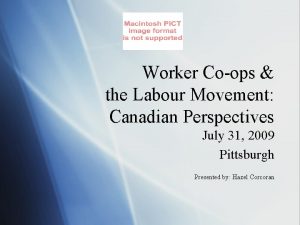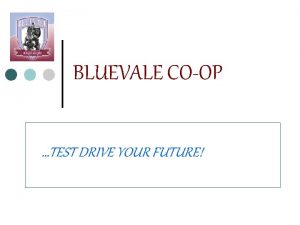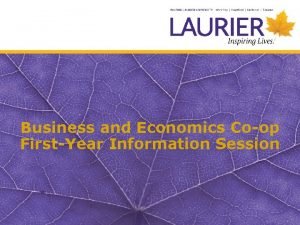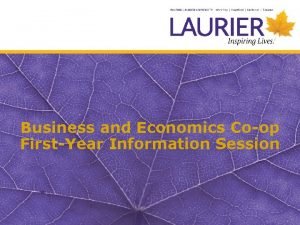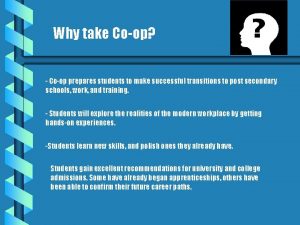WORKER COOPS AN INTRODUCTION Canadian Worker Coop Federation


















- Slides: 18

WORKER CO-OPS: AN INTRODUCTION Canadian Worker Coop Federation Session #2

Introductions • Who are you, in what worker co-op do you work? • What are two things that you like about the way your co- operative is controlled/managed by the members? • What do you think are important skills and knowledge members must have to control their co-operative effectively?

Governance and Management: Creating Your Co-operative Vision • Effective governance and management are what will enable your co-op to successfully create its vision while embodying the Co-operative Values and Principles in all its activities.

Summary of Governance & Management Members R e c i p r i c a l Workers (Members & Employees) Elect Co-op Vision/Purpose Viable Enterprise Co-op Values & Principles Articles of Incorporation Bylaws & Policies Reciprical Board of Directors A p p o i n t Management: Collective and/or Hierarchy

Member Participation • Joint-ownership and democratic control require member participation. • Participation requires: • (a ) people actively engaging to make sense of their environments and using this knowledge to guide their choices; • (b) people being in positions in which they have the capacity (knowledge, ability, commitment) and responsibility for actions of importance to the co-operative’s activities and results; • (c) they have shared a vision of the common good toward which they are striving; and • (d) this common good also has an important component of individual and organizational success.

Governance and Management Tasks • Responsible For - The actions and decisions the members, workers (operational roles), directors and managers are empowered to carry out (develop budgets, approve new members, etc. ) • Authority From – From where do they receive their Authority to take these actions and decisions? – (law, bylaws, operations policies, job descriptions, etc. ) • Accountable To – To whom are the individual, teams, committees etc. accountable? (members, work team, manager, board of directors, etc. )

Decision Making/Task Matrix - Sample Task/Decision Who Proposal Development When/Where Decision Process Implementation Task or Outcome Approve wage policy Members Board, Wage Committee, Management General Meeting Majority vote Management/ Administration Elect Directors Members Nominating Committee General Meeting Majority Vote Board of Directors Approve Annual Budget Board Management/Fi nance committee December Board Meeting Consensus Board, Management, Members & Employees Production Schedule Production work team Management, sales administration Weekly at Friday team meeting Consensus Production work team Provide Superior Product or Service to Client Worker (employee or member) Service Policy Guidelines, Management Daily or as required Policy Guidelines with Individual Judgement Worker and Management Organize Annual Meeting Governance Committee, Board, Management GC, Board, Management March 1 to April 15 Consensus Governance Committee

Decision /Action Process - Participation Identify Task or Activity: Shared Vision/Sense Making Develop/Reflect upon Options Use Knowledge and Creativity Evaluate Results Making Sense of the Situation – Did the action have required results Implementation – Take Action Personal Initiative & Responsibility Decision – Choose between Options Real Responsibility

Adopting a Motion or Proposal Clarifying Questions Actions/ Commitments Structured Discussion Gauge Reaction Some Concern s Proposal Approved No Concerns Address Concerns List all Concerns Call for Vote or Consensus Restate Amended Proposal Return to Clarifying Questions Proposal Not Approved Plan for Alternatives

Consensus and/or Majority Voting • Does your co-op use consensus or majority voting to reach governance decisions? • Is the same process used for operational decisions? • What do you think are the strengths of your co-op’s process? its weaknesses?

Challenge of Conflicting Objectives • Decision-making often requires trade-offs between conflicting desires or goals • Financial commitment to long-term viability; financial viability may conflict with short-term wage desires (maximizing wage rate) • Desire to provide member education may be in tension with financial needs or time constraints to serve customers

Mediating Conflicting Desires or Goals • Always refer back to the Vision and Purpose of the co- operative to ensure a compromise between goals will still serve the Vision effectively. • Engage in “constructive controversy” to hear all view points and alternatives and to avoid “group think”. • Have discussions well facilitated to ensure full participation, i. e. ensure everyone is heard • Develop clear criteria for governance and operational decisions

Blood and Oxygen: Critical Criteria • Two critical criteria for the long-term success of a co- operative. • What do you think “Blood” and “Oxygen” represent?

Cash and Member Commitment • When making governance or management decisions always ask how will this affect: • Our cash position – our ability to pay expenses and invest in vital assets or activities for the future • Our members’ commitment to remain a member of the co-operative for the long-term

What is CWCF? • A national, bilingual, grassroots federation of worker co-operatives, and multi-stakeholder cooperatives with substantial worker control. • Types of members: • Worker & multi-stakeholder co-ops • Regional Worker Co-op Federation members • Co-op Developer members - through Coop. Zone • Associate members • Offices in Calgary, Winnipeg, and Kentville, Nova Scotia

CWCF Vision To be a growing, cohesive network of democratically controlled worker co-ops that provide a high quality of worklife, and support the development of healthy, just and sustainable local economies, based on co-operative values and principles.

CWCF Services • Tenacity Works Investment Fund • Technical assistance program • Access to hard-to-find information on WC’s • E-Newsletter • Lobbying for worker co-op interests • Annual fall Conference • RRSP-TFSA program for investment in co-ops of all types, & CED Investment Funds (NS, etc. ) • Group insurance program (The Co-operators)

Closing • If you were to share one thing from this session with the members of your co-operative, what would it be and why do you think it is worth sharing (What difference could it make in your co-operative’s life? ) • Evaluation – What did you like about today’s session? How could it be improved? • Thanks for participating!
 Adam van coops
Adam van coops Umich coops
Umich coops Family support worker qualifications
Family support worker qualifications Marketing an introduction 6th canadian edition
Marketing an introduction 6th canadian edition Coop per me e per te
Coop per me e per te Toi et moi basel
Toi et moi basel Coop szlogen
Coop szlogen Langara co-op
Langara co-op Coop äriklient
Coop äriklient Co op funeral plans
Co op funeral plans Hls coop
Hls coop Agdao cooperative benefits
Agdao cooperative benefits Continuity of operations plan definition
Continuity of operations plan definition Dequeen mena educational coop
Dequeen mena educational coop Midata coop
Midata coop Drumlin coop
Drumlin coop Ul coop report
Ul coop report International cooperative programs
International cooperative programs Cas coop
Cas coop

